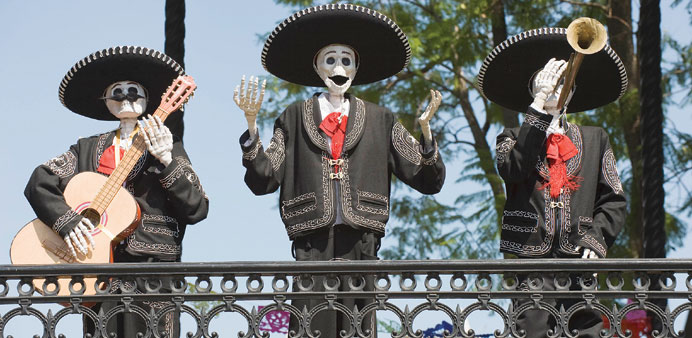TRADITION: Papier-mache skeleton figures dressed as musicians for the traditional Day of the Dead festivities in Mexico.
By Itzel Zuniga
Mexicans tend some unique cultural and musical rituals with ancient roots that demonstrate their affinity with death and an obsession with the afterworld.
One of these rituals takes place in Veracruz state where indigenous people belonging to the Zoque, Mixe and Popoluca ethnic groups, the latter descendants of the Olmecs, the most ancient culture in Meso-America, help their deceased ones reach the afterworld with music, song, food, dance and even old clothes and shoes and leftovers.
Twenty-one days after a loved one has died, the community gathers together to play “dead and lost-soul ‘sones’” (pronounced ‘sonh-ehs’) as part of a Catholic ritual that has its origins in pre-Hispanic customs. In some villages the family waits 40 days, more in keeping with the Catholic tradition.
“The ‘ghost or dead-people sones’ are so called because they are supposed to help the deceased find his or her way. We are talking about 150 ‘sones’, and they are played accompanied by a violin and a ‘jarana’ (pronounced ‘hah-rah-nah,’ a stringed instrument). The tunes are played at midnight. Not all of them: a selection is made,” explained anthropologist, archaeologist and historian Alfredo Delgado.
The intention is, following syncretisation with Christian belief, that the music and singing will convince Saint Peter to open the doors of Heaven for the departed. But in fact “what the lost soul does is to re-enact what Homshuk, the Popoluca Deity of Maize, did when he was on Earth for 21 days,” Delgado told DPA.
Delgado, a researcher with the Mexican National Anthropology and History Institute, is an expert in these types of musical forms and compiled a record in 2000 called “Dead and Lost-Soul Sones” which contains 23 ghost songs.
“As in all societies, in pre-Hispanic culture, individuals refused to die. They knew that, inevitably, that moment would come, but they sought ways to avoid it. Thus they created other worlds with opportunities for that time after death,” archaeologist Eduardo Matos Moctezuma has written in his book, Death at the Edge of Obsidian: How the Nahuatl People Confronted Death.
All Mexicans lavishly celebrate the Day of the Dead in November, a feast that Unesco in 2008 declared a part of the Cultural Heritage of Humanity. Papier-mache skeletons are made and outfitted with guitars as part of these festivities.
The lost-soul “sones” are a form of Jarocho “sones,” that took root in Sotavento, in the Mexican states of Oaxaca, Tabasco and Veracruz.
In 2014 Mexico proposed that Jarocho “sones” (one says a “son” in the singular) be declared a part of the Intangible Heritage of Humanity.
Jarocho “sones” are lively and gay; they are generally played during a fandango, a popular Mexican feast with music, dance, poetry and song with strong Spanish influence.
However ghost “sones” are sadder and with religious overtones. The “sones” chosen at a person’s funeral must match the deceased. For example the “stingray son” is chosen for fishermen, the “horse son” is played for a bargeman or cowboy, a soft “fandango” is played for a woman, and the “son for little ones” when it is a child who has departed.
The ceremony for the deceased person begins with a Catholic mass in his or her honour. Then relatives and friends prepare a special meal shared by all those present.
Then they gather some of the dead person’s belongings. They throw old shoes and clothes into the stream, as they do leftover food from the feast. These items are not considered rubbish but rather objects that nobly fulfilled their purpose and can follow the person on his or her way to the afterworld.
Delgado explained that relatives also make an offering of the brains of a hog in the same place.
“The intention is to prevent ‘Joonchu,’ a rubber dwarf who lives on the hills, from sucking out the brains of those who broke the rules,” he said.
Ancient peoples such as the Nahuatls or Aztecs, the Popolucas and the Toltecs believed that when they died, souls needed to pass through seven underworlds, making their way through a forest filled with animals, a desert or rivers.
These elements are found in several post-colonial manuscript books illustrated by indigenous people in Mexico.
Archaeologist Matos Moctezuma mentions the dead-people or lost-soul “sones” in his book. He explained for example that at a ceremony for the deceased, musicians play the “cloud son” so that the dead soul may receive water as he or she crosses through a desert and the “monkey son” for help climbing through a forest.
The precise origins of “dead people and ghost sones” are unknown although it is believed that they were created in the 17th century. They have survived through oral tradition.
But experts warn that they are now in the process of disappearing. Fewer and fewer indigenous communities carry out the ceremonies for the dead souls; there are fewer and fewer musicians who can play the “sones” and fewer and fewer artisans making the instruments needed to accompany them. —DPA



